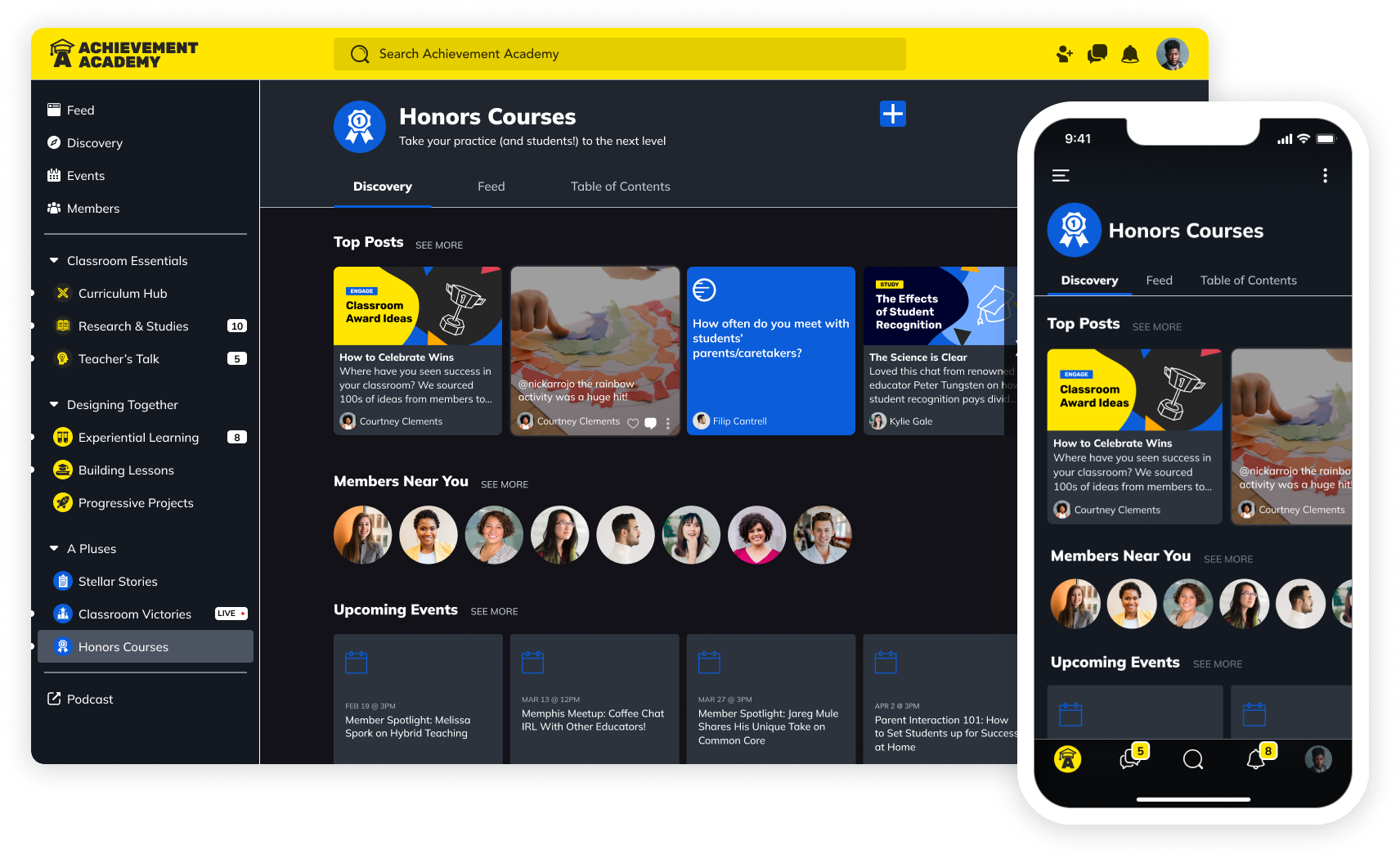Online Courses
Here’s the Easiest Way to Start an E-learning Business in 2025 (9 Steps)
If you’re ready to build a thriving business around sharing your knowledge, here’s what you need to know.
Author
Mighty Team
Last Updated
August 14, 2025

E-learning is a booming business. The industry is projected to hit $848 billion by 2030, while the mobile learning market alone was projected to hit $155 billion by 2026.
For creators, brands, and businesses looking to enter the e-learning industry, there are a TON of opportunities with the growth of e-learning platforms AND the fact that more and more of us are comfortable learning online.
In this article, we’ll introduce you to some of the concepts in e-learning, walk you through how to build an e-learning business, and introduce you to some of the platforms to help you do it.
What is e-Learning?
E-learning describes a learning environment that is digital as opposed to in-person (electronic learning). In the late 1980s, the idea of computer-based training (CBT) came out, and the wide scale adoption of the internet led to the online version of CBT: web-based training. By 1999 the term “e-learning” was coined to describe this new way of learning through digital mediums.
Even by the late 90s, people could see the potential of e-learning, not just to teach, but also to facilitate connections between students and teachers AND to change the way we take in information. But in the early 2000s, the tech possibilities exploded with more comprehensive learning management systems (LMS), a better understanding of virtual pedagogy, and studies showing how effective e-learning could be (Source).

Today, we’re still seeing an evolution in e-learning, from mass adoption by higher-ed during the pandemic to the integration of AI into e-learning platforms. And tech has created a TON of different forms for e-learning, from video to text, from asynchronous to synchronous, with advances in learning communities and different forms of evaluation.
If you glossed over this history, here’s the TLDR; Whatever your plans for your e-learning business, there’s never been more opportunity–e-learning platforms have matured AND we’re used to using them!
What is an eLearning business?
An e-learning business will create and deliver digital learning content is a major part of its business model. Some e-learning businesses sell e-learning directly, monetizing through course sales. And some e-learning businesses use e-learning to supplement a more diversified business model.

The benefits of e-learning
E-learning has some serious benefits for both learners and teachers alike:
Accessibility: From self-directed interest courses to higher-ed, e-learning dramatically changes the accessibility of knowledge. Students can get college-level education from anywhere OR learn from top leaders in a field they would NEVER have access to normally.
Scalability: E-learning tech means that you can scale your e-learning business like never before, reaching more students with less effort.
Flexibility: Traditional higher ed had limited ways of delivering knowledge– e-learning turns this on its head and lets you teach the way you want. Students can learn in different ways and have learning reinforced with things like online communities, discussions, live streaming, virtual office hours, quizzes, and more.
Ease of access: Widely available e-learning platforms means that pretty much anyone can start an e-learning business.
Focus: E-learning lets students focus on acquiring the information they need when they want.
Concepts in e-Learning
As you're considering either creating an e-learning business or incorporating e-learning into an existing business, there are a few concepts that you should know. Understanding these will make it WAY easier to choose your approach to e-learning and pick the right e-learning platform for your business.

Asynchronous vs. synchronous
There are two words you’ll see thrown around a lot in e-learning circles: asynchronous and synchronous. This is basically a fancy way of saying live learning or pre-recorded learning.
In the early days of e-learning, platforms usually did pre-recorded courses. You would build your course on an LMS and your students could go through it after leisure.
Synchronous learning is becoming more common as livestreaming platforms become more common AND people search for the interactivity of live learning. For example, we're seeing huge growth in cohort courses–that's a course that can be pre-sold and delivered live by an instructor to a group of students virtually.
You can use this chart to help you decide which type of learning is best for your e-learning. Don't forget the two are not mutually exclusive. For example, if you were to record a live course and sell copies of the recording, it could be both synchronous and asynchronous.
If Yes... | If No... | |
|---|---|---|
Are your students self-directed and autonomous? | Try Asynchronous | Try Synchronous |
Does your material ever change? | Try Synchronous | Try Asynchronous |
Do students require live feedback and support? | Try Synchronous | Try Asynchronous |
Do your students have limitations in joining through a live session, either because of learning style or lifestyle? | Try Asynchronous | Try Synchronous |
Will the students need to workshop ideas, have discussions, or work together? | Try Asynchronous | Try Synchronous |
Social learning
Social learning theory recognizes that learning is more than just receiving information; we learn through social interactions in a group. The concept was coined by Albert Bandura, who recognized that learning was impacted by observing, imitating, and testing behavior.
Obviously, traditional e-learning on a synchronous LMS made this impossible; you’re not learning from or imitating other students when you’re sitting in a room by yourself watching a course.
But new advances in e-learning tech make it possible for people to come alongside each other and learn together.

Mixed mediums
Until a decade ago, it was common to think that people learned with different styles. For example, people will often say that they are “visual learners” or “tactile learners.”
If you go down the rabbit hole on studying learning styles, you’ll see that there isn’t much evidence that humans have different inherent learning styles.
BUT, it’s pretty clear that people have different LEARNING PREFERENCES!
Since many e-learning platforms give you different ways to deliver content, it’s pretty easy to mix different types of learning together to help give people different options.
Microlearning
Microlearning is also another really useful concept to know as you plan your e-learning business–in this case, learners learn in short bursts. One awesome example of microlearning is Duolingo, with its famous claim that you can learn a language in as little as 10 minutes a day.
Microlearning is small, bite-sized learning experiences spread out over a long period of time. And it can be a great e-learning approach if your business caters to busy people.
Gamification
Gamification is another popular approach to learning in which learning is delivered with game-like features. For example, if your e-learning course has a leaderboard that ranks people based on accomplishments, you’re seeing gamification.
There are all sorts of ways e-learning can be gamified to make it fun–and even a bit addictive. It can help to keep students motivated.

Putting this all together
You might be saying, "Sure, these are great concepts. But how do they apply to my e-learning business?"
Basically, as you plan your e-learning business or e-learning offerings, you'll need to decide how to deliver teaching and evaluation. And, to some extent, the way you deliver information will be impacted by: your teaching preferences, your students’ learning preferences, and the platform you choose.
And of these three things, so much is resting on choosing the right platform. Some platforms like Teachable only have an option to create a pre-recorded course. Some e-learning platforms have Incorporated gamification features. Some let you deliver microlearning really efficiently. Some let you mix and match delivery options.
As we go through the steps to building an e-learning business below, keep these concepts in mind as you plan how you think you’d best serve your students.
Is it elearning or e-Learning?
Okay, let's take a fun little time out here. Because whenever we start talking about e-learning, people are going to lose their minds over how it's spelled. Technically, e-learning is probably correct. The hyphen joins two adjectives (e.g. "electronic-learning platform").
But you do you. Spell it however you want. We won't judge.

How to start an e-Learning business
1. Choose an ideal student
It all starts with your ideal student. If you get this right, you can build an e-learning empire. You need to know exactly who you’re helping and how you’re helping them. For example:
You might be helping companies educate their employees on DEI.
You might be teaching a valuable skill you’ve learned (e.g. social media marketing)
You might be supplementing or moving a college course online
Whatever you decide to teach, it all comes down to a student’s transformation. Your ideal student is a person looking for a transformation. They need to know a skill and apply it. Or maybe they need to get an accreditation.
If you can have a clear understanding of what your ideal students need and want, you’ll be way more successful in your e-learning business.
And you don’t need to guess. One of the absolute best exercises, if you’re starting an e-learning business, can be to interview potential students.
2. Choose a monetization model
There are a lot of different ways eLearning businesses can monetize their content. Here are some examples of different monetization models in action.
Pay-per-course. Instructors create courses and charge a course fee for students (e.g. Udemy).
Marketplace. Instructors put courses on a marketplace with other courses and earn royalties from the marketplace (e.g. Skillshare).
Freemium. Learners can access e-learning for free, but pay for premium features (e.g. Duolingo).
Ad-supported learning. Learning is always free, but it's supported with advertisements (eE.g. YouTube).
Affiliate monetization. E-learning is free but supported with opportunities for affiliate purchases (e.g. a free YouTube bookkeeping course that uses the QuickBooks affiliate program).
Not directly monetized. Many businesses offer e-learning for free to help people learn to use a product they sell or to help employees be more successful. In these cases, e-learning isn't directly monetized but contributes to broader business goals.

3. Choose your delivery needs
Whether you believe in learning styles or not, there are two things every learning instructor needs to decide: how they prefer to teach and how their students prefer to learn.
Here are some of the tools that your disposal when it comes to e-learning:
Pre-recorded video content
Live streaming
Short-form text content (e.g discussion forum)
Long-form text content (e.g. blogs or articles)
Courses structured around an LMS
Courses delivered live
1:1 or small group teaching
Audio learning
Chat & messaging
You probably already know how you like to deliver content. But–again–if you don't know how your potential students like to receive content, ask them! Doing a few interviews with potential students could help you understand what they want.
And often, your students' preferences are dictated by lifestyle. If you are creating courses for busy executives, don't expect them to sit for hours and hours. Figure out how to give them information fast.
4. Choose your platform
When we're talking about delivery needs, we are actually starting to talk about platforms. Most e-learning is done on some sort of event platform.
You need to choose a platform that lets you deliver content in a way that fits you.
But on top of the actual learning content features of a platform, there are other things you should think about.
For example, how about monetization? If you are selling courses, you'll need a platform that lets you handle sales. This should include a payment gateway, different currency options, and the ability to bundle.
Or what about moderation features? If you have user-generated content and discussion forums, you probably need to be able to moderate to make sure the discussion stays positive.
Member management tools can be really important to help you see who your class members are and where they are at in their learning.

5. Validate the idea
A lot of e-learning businesses will just launch. But it can be really valuable to validate your idea before you go in at the deep end.
Take it from us, it can be demoralizing to spend weeks recording a course that nobody ever watches.
So at this stage in the game, it's a good idea to validate your e-learning business with some sales.
If you have your platform in place, can you create a small offer for your ideal students to pre-sell?
For example, if you create a cohort of course offers, you can sell tickets to a live course before ever delivering it. If you can't sell enough, you can simply refund the tickets if need be as you try to adjust the offer. Or, you could sell a webinar or live event as a way to validate your e-learning idea.
Validating any business idea is a vital step to success.
Validation for corporate e-learning
Even if you're not selling e-learning, if you are just adding it to an existing business, you can go through a validation process. The trick is still to start small and see if you can get buy-in.
For example, if you are creating training for your employees, can you have some of the employees drive the process? Can you ask them what their needs are for e-learning instead of just guessing? And can you find simple ways to assess if the training is valuable before you go all in on it?
6. Figure out customer acquisition
Believe it or not, the hardest part of starting an e-learning business isn’t choosing your platform or recording your lessons. It's getting people to show up.
Most e-learning companies fail at this part. So somewhere along this process, you need to figure out how you will actually get customers. Maybe you're an influencer with a huge audience and you're pretty confident you can leverage a bunch of those followers into e-learning students.
That's great.
But for those who don't have this luxury, you'll need to learn how to acquire clients.
For most e-learning businesses, one or two really good acquisition channels will do most of the heavy lifting. For example, it's tempting for a business doing corporate training to think they need to be on every single social media platform every day. Chances are, they could probably get all the clients they need by just focusing on LinkedIn.
This is the principle of client acquisition. You don't need to shotgun to every single possible acquisition channel. You need to figure out a few solid channels to fill your funnel.
Think outside the funnel
Funnel is a marketing term that describes getting a lot of potential leads into your list, and progressively narrowing them down until they either buy or disappear.
But there is another alternative. We’re really big on the value of a community flywheel instead of a funnel. When people join an online community, it takes the place of a funnel by creating a space where people can connect, learn, and grow. Your leads are constantly being nurtured without you needing to create high-pressure sales tactics.
You can create a community to support your e-learning business, and even charge admission! The average community on a Mighty Network charges $39 a month. And 90% of the communities that charge membership also make upsells to other products–like e-learning offerings.
A community is one of the very best ways to grow your e-learning business.
7. Create your first e-learning experience
Once you have your first numbers in your platform and you figure out customer acquisition, you can start trading e-learning experiences. However you choose to deliver your e-learning, actually doing it should be most of the fun.

8. Offer more to current students
There's a mistake a lot of new e-learning businesses make once they have some success: they go back out and look for a different type of client or a different offering.
It's normal to think this way, obviously growing your market share can work to grow your business.
But one of the biggest missed opportunities is to go deeper on serving your current clients.
Often, we see enormous revenue growth from Hosts who double down on doing more for their current audience. Think about things like:
Coaching
High-ticket products
More in-depth learning
Mastermind groups
Accountability
Live events
9. Learn and adapt
Any e-learning business will need to learn and adapt as they go. People change. The market changes. New, game-changing software comes out and makes your current offering redundant.
It happens.
Recognize that your path to running an e-learning business will have some ups and downs and that you'll need to adapt as you go.
And just a note. Having a platform that gives you detailed analytics can make it way easier to understand what's working and what isn't.
Ready to get started?
If you’re ready to launch your e-learning business, why not get started right now? Mighty Networks is one of the most powerful e-learning platforms on the market, letting you mix your courses with content, community, events, and commerce. You can teach both asynchronous and synchronous courses, with flexible Spaces that let you add in livestreaming, course discussions, polls and questions, member profiles, and more.

With Mighty, you can monetize in 135 currencies, selling memberships, course sales, events, groups, or bundle any of these. It comes with a beautiful, responsive app for every device. AND if you’d like, you can even get your own e-learning app under your own brand – book a call with us and we’ll show you how.
Ready to start building your community?
Start a free 14-day trial to explore Mighty—no credit card required.
More like this
Join Mighty Community
Learn the principles of Community Design™ (and see them in action) alongside thousands of creators and entrepreneurs. It's free to join!

Online Courses
Creating a Course
Teaching a Course
Course Platforms
Selling a Course
Communities & Memberships
Community Platforms
Managing a Community
Building a Community
Growing a Community
Monetizing a Community
Content Creation
Creators & Entrepreneurs
Monetization
Content Creation
Starting a Business
Website Builders
Creating & Managing a Website
Events
Event Platforms
Hosting & Marketing Events
Branded Apps
Creating a Mobile App
Coaching Apps
Community Apps
Coaching
Mastermind Groups
Starting a Coaching Business
Coaching Platforms
Filter by Category
Online Courses
Communities & Memberships
Creators & Entrepreneurs
Events
Branded Apps
Coaching
Build a $1 Million Community
This free masterclass went viral—sign up to learn why.

























